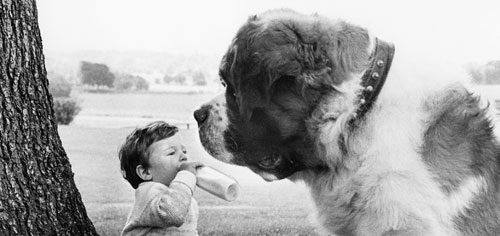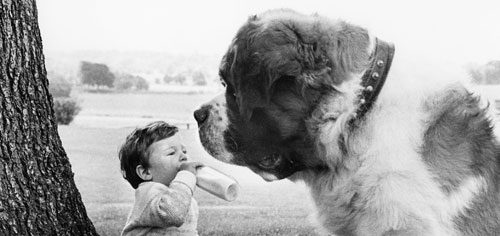

Brit Photographer John Drysdale and His Canine Subjects
Unleashing the Essence of Joy
Of the many gifts dogs bestow upon mankind, their ability to put smiles on our faces, even in the most difficult of times, is surely one of the greatest. Our dogs captivate and delight us with their quirks, their antics and their seemingly limitless capacity for joy. But as any dog owner knows, photographing those wonderful qualities and unique moments that make our canine companions so special is most often impossible. By the time we get the camera out, the moment is gone-and despite our best efforts to position, bribe and cajole, we are unable to recreate that spontaneous magic.
This makes the work of British photographer John Drysdale all the more remarkable. Drysdale, whose diverse career has spanned half a century, has produced some of the world’s most memorable dog photographs-timeless images that capture the true spirit and undeniable joie de vivre of man’s best friend. Many of these have been collected in Drysdale’s latest book, My Love Unleashed (St. Martin’s Press 2002), a must have for any lover of dogs or photography.
That Drysdale has a particular affinity for photographing dogs and other animals is not surprising, given the circumstances of his rather unusual childhood. "I grew up in a very remote part of Uganda, on Lake Edwards, where we were surrounded by every kind of wild animal you could think of," he explains. "We had things like monkeys and bushbabies as pets, but we didn’t have dogs at all because they would have been eaten the first day."
What the family did have was a cat-and a rather large one at that. "Num-Nums," as she was called, was one of three orphaned lion cubs brought home by Drysdale’s father in 1948. Though the other two soon became too fierce to keep and had to be sent to a zoo, Drysdale recounts that "Num-Nums captured all hearts by displaying no wild tendencies." The family decided to keep her for a while and found her absolutely enchanting.
Says Drysdale, "She used to carry her feeding bowl in her mouth and follow us on quite long walks. At the age of about 18 months, when she was nearly full grown, she was quite as tame and placid as Elsa, the now-famous ‘Born Free’ lioness, and was as trustworthy as a family dog. However, she required 14 pounds of good quality meat each day and was making people in the area nervous, especially when she went out walking with us. So she had to be found a new home, which proved to be difficult. South African zoos had lions aplenty." They eventually found a home for Num-Nums with the Phoenix Park Zoo in Dublin, Ireland, but it was a very sad day when she left, and Drysdale never expected to see her again.
However, when he found himself in Dublin three years later, he went to visit his old friend. "When I recognized Num-Nums and called her name, she instantly stood up and became very alert. She seemed to have lost her visual memory of me, but when I called again there was no doubt that she remembered my voice and became very excited, perhaps hoping I had come to take her home." Drysdale spoke to the keeper and told him the story, but the man thought he must be mad and would not even consider letting him pet her. "It was sad to part again and not be able to make contact, and very upsetting to see her ‘in the wrong place,’" says Drysdale, but he was grateful that she was at least alive and in good health.
Not all of the Drysdale family pets were so exotic, though some were just as special in their own, more domestic way. After the family moved to a less remote locale, they owned a number of dogs. One in particular left an indelible mark on Drysdale’s heart for that dog’s loyalty to Drysdale’s seriously ill sister. "Patch was a mongrel of indecipheral origins, and he was very close to my sister, who had rheumatic fever and was in and out of hospital regularly," Drysdale explains. "We lived in the country outside Johannesburg at the time, perhaps about five or six miles from the hospital. The dog was very upset when my sister was taken away in the ambulance and followed it for a while, but then of course couldn’t keep up. We would go visit my sister every day, and what must’ve happened was that the dog followed our car as far as it could, then lost it at a certain spot. Then the next day, we think he must have gone to that spot, waited for the car to come by, and then followed it again. After a number of days, I think about a week or so, Patch arrived at the hospital."
According to Drysdale, the hospital was furious and said it couldn’t allow dogs in, but the dog would turn up every day, wait for someone to open a door, and proceed inside. As Drysdale remembers, "Patch always found my sister, and every day we were ordered to take the dog away. However, there was one very good doctor who noticed that my sister seemed to improve-her blood pressure and temperature and everything-when the dog was around, and she went down when it wasn’t. So they discussed this and decided to make an exception, and the dog was allowed to come in and lie under the bed. It did quite a lot for my sister-sort of built her morale a bit. The amazing thing was how the dog figured out the way to get there. He was clearly very intelligent."
Drysdale continued to be enthralled by animals both wild and domestic, but in his teens found a new interest that quickly became a passion-photography. He got his start with an old box camera, and soon wanted to develop his own film. Unbeknownst to his father, he set up a darkroom in an unused 2,000-gallon water tank in the yard. Although it was often sweltering in there, the arrangement proved quite satisfactory-until the day his father decided to have the tank moved. "I was inside it at the time," explains Drysdale, "and because of the noise it made rolling around, he couldn’t hear that I was in there, tumbling around like in a washing machine, my chemicals and things going every which way. It was a rather bad start." Fortunately for Drysdale-and for lovers of photography the world over- things soon began to look up.
While visiting relatives in England, Drysdale was invited to study at the prestigious Guildford College of Art, and he jumped at the chance. "I didn’t know until later that if I’d been British, there was a waiting list of 300 people for every single place offered. However, they wanted to internationalize the school, and as I was the first person they’d ever heard of from Uganda, I was invited to go there. That changed my life straightaway." At twenty years of age, John Drysdale was well on his way to becoming a professional photographer.
After two years at the college, Drysdale began his career with a bang, landing a dream job at the legendary Vogue Studios in London. Then, as now, Vogue magazine was the international bible of style, and Drysdale suddenly found himself in the company of the world’s top fashion and portrait photographers. "Vogue Studios was host to Cecil Beaton, Norman Parkinson, and many other wonderful people, including well-known Americans. They used to come over and do photography for Vogue magazine- English, French, Italian and American. It was a very good move for me, because after the war, you couldn’t get colour film-it just wasn’t available- but Vogue had unlimited access to colour film coming in from the U.S.A. That was another bit of luck for me."
His first major assignment was assisting Beaton in photographing all the royals of Europe, in Buckingham Palace, after Queen Elizabeth’s 1953 coronation. Though he and Beaton struggled to obtain decent shots of some of the royal children, including a rambunctious Prince Charles and his high-spirited sister, Princess Anne, Drysdale found that he greatly enjoyed photographing children. Over the years he would take many remarkable photographs of children, many of them showing a child enjoying the company of an animal friend. He also became well known for capturing wonderful images of unusual inter-species animal friendships, such as "Puppy Loving Chimp" (1970) and the famous "Bulldog Watch" (1969) (see "Cross-species Friendships," Modern Dog, Spring 2004). When asked how he manages to get such stunning pictures of children and animals-two notoriously difficult subjects that most photographers dread- Drysdale says, "They lose interest very quickly, so you have to get what you can at lightning speed. I’ve always had several cameras all loaded with film and lenses so that if one runs out I can grab another. And you take advantage of what happens. I usually have someone who knows both the animal and the child helping. I’ve worked with some people again and again because they were so good at handling both the animal and the child. With others it was quite different-it all folded up quite quickly and ran amok. Overall, there is a good amount of luck involved."
There is also a good amount of talent involved-one might even say genius. But to the ever modest Drysdale, his extensive list of publishing credits, exhibitions and awards- including prizes from British Press Pictures of the Year and from World Press Photo will always be graciously attributed to a series of lucky breaks. If that is the case, all this writer can say is: thank you, Lady Luck, for bringing the beautiful, joyous work of John Drysdale to the world. ■
Susan Kauffmann writes regularly for Modern Dog. She lives in Vancouver with her Alaskan Malamute, Kuma, who loves to have his picture taken.
Join the newsletter and never miss out on dog content again!
"*" indicates required fields
By clicking the arrow, you agree to our web Terms of Use and Privacy & Cookie Policy. Easy unsubscribe links are provided in every email.